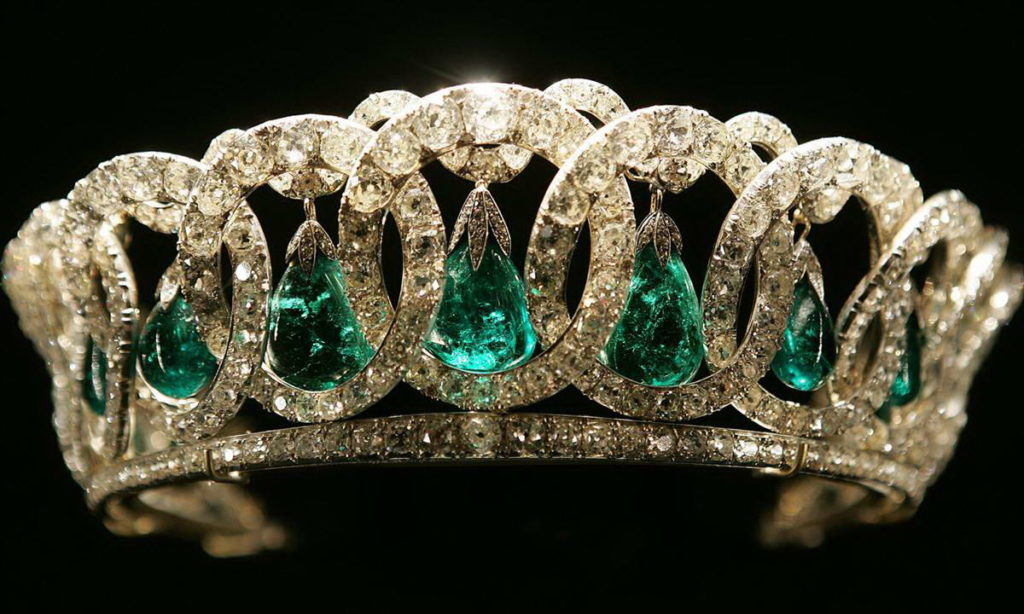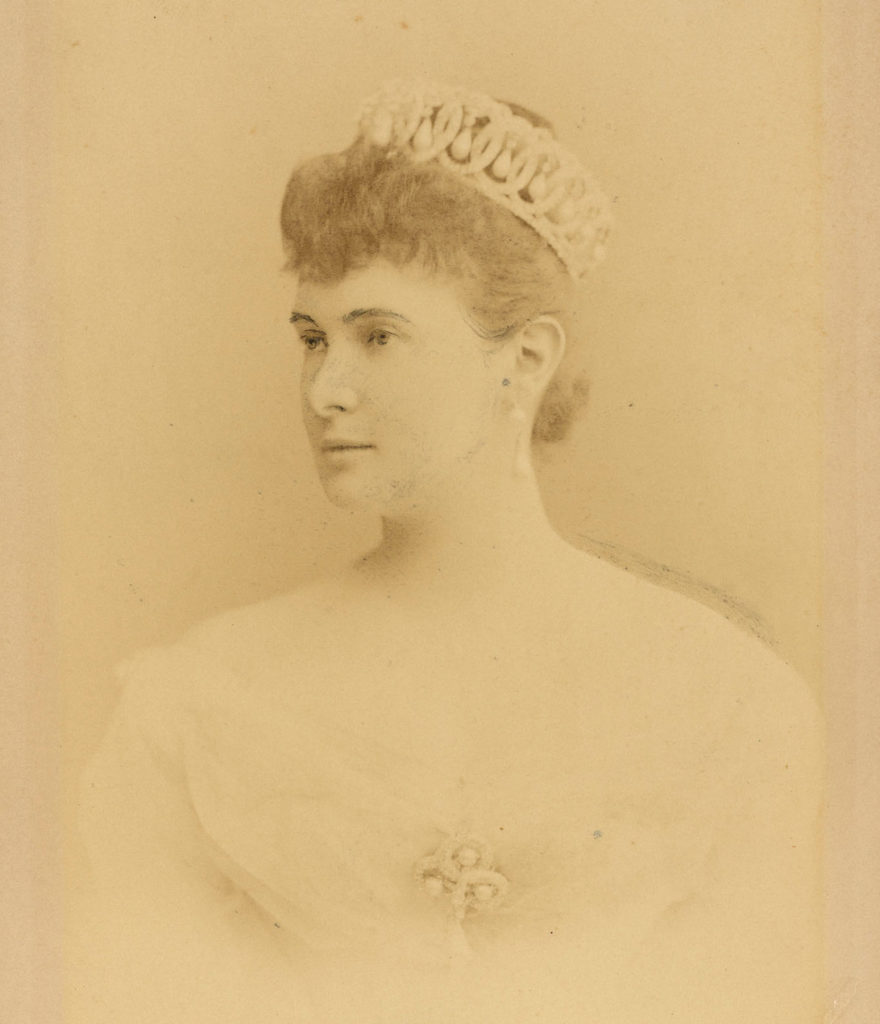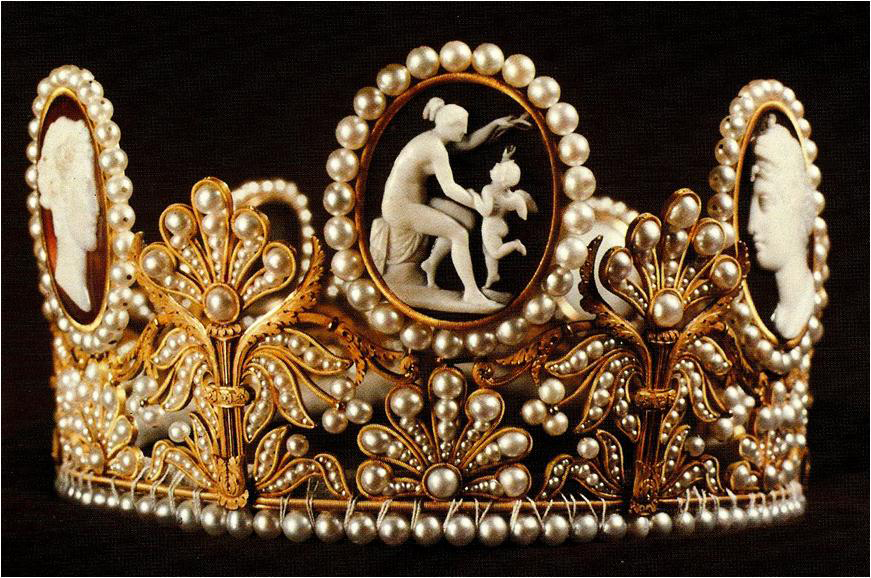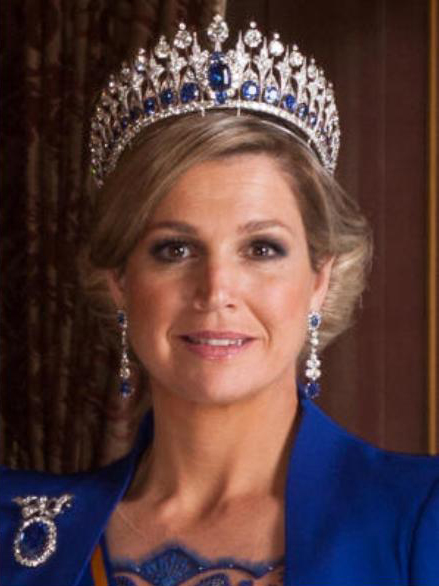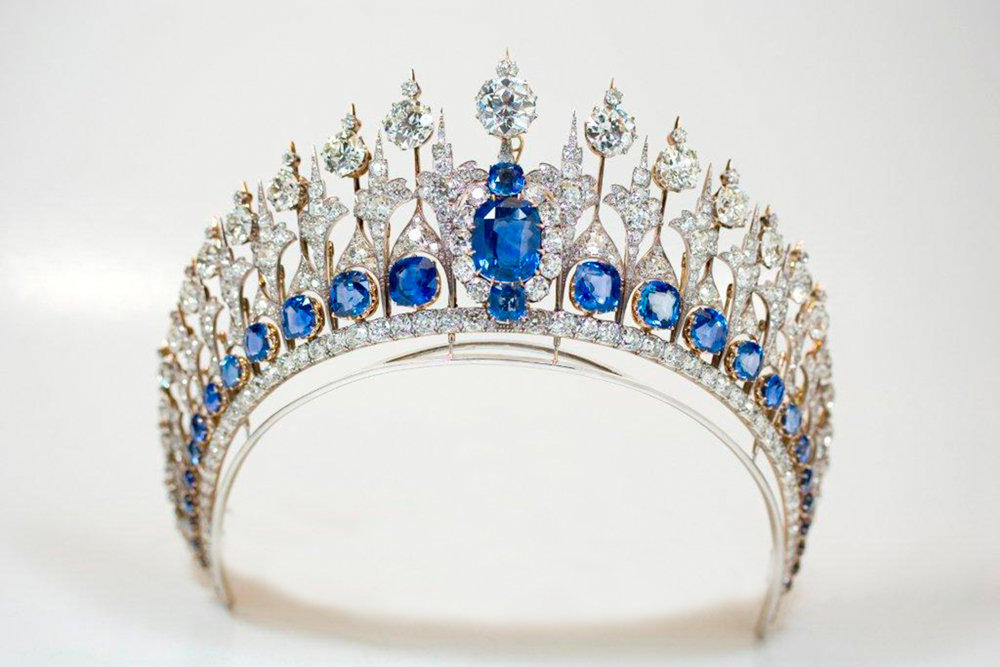A list of the most expensive and beautiful Crown Jewels worn by the royal families of England, Sweden, Spain, the Netherlands and Denmark.
ENGLAND
The Grand Duchess Vladimir Tiara
Year Made: 1874 by Bolin, the Russian Court Jeweler
The Grand Duchess Vladimir (Maria Pavlovna, wife of Grand Duke Vladimir Alexandrovich) was the aunt of the last Tsar of Russia, Tsar Nicholas II (murdered in cold blood by the Bolsheviks in 1918). The grandest of the grand duchesses of Russia, her wonderous jewelry collection included this tiara with intertwined diamond circles tied together with a diamond ribbon, and which hung pendant pearls. When the Russian Revolution struck, she hid the piece (along with the rest of her collection) in the vaults of the Vladimir Palace before she fled St. Petersburg, until it was smuggled out by the British Secret Intelligence Secret Service in a plain bag. When it was returned to her, she gave it to her daughter Princess Nicholas of Greece, who sold it in 1921 to Queen Mary, and it was inherited by Queen Elizabeth II. The most versatille piece in the Queen’s tiara collection, it can be customized with emeralds, swinging pearls, or worn plainly.
The Cambridge Lover’s Knot Tiara
Year made: 1913 by Garrard

Queen Mary fashioned the design after a tiara owned by her grandmther Agusta, the Duchess of Cambridge. Originally featuring a top row of pearls, Queen Mary over time redesigned the piece, removing the pearls but keeping the pearl pendants in place. After her death, Queen Elizabeth II wore it for quite a while, but it didn’t receive its zenith as an iconic tiara until it began gracing the head of Diana, Princess of Wales. Although she often complained of its weight and the noise the pearls would make as they swung against each other, she wore it often enough that it was considered her favorite headpiece. After the divorce between the Prince and Princess of Wales, it stayed unworn until it made an appearance on Catherine, the current Duchess of Cambridge in 2015 for a diplomatic reception at Buckingham Palace. To suit Catherine’s darker hair, the base is now wrapped in dark velvet, compared to the light base during Diana’s time.
Queen Alexandra’s Kokoshnkik Tiara
Year made: 1888 by Garrard

A gift for the silver wedding anniversary of the future King Edward VII and Queen Alexandra, this tiara was inspired by Alexandra’s sister the Empress Marie Feodorovna of Russia, and the traditional Russian headress the kokoshnik, which inspired a number of other tiaras during the time period. This piece includes 61 platinum bars containing 488 diamonds, and while it isn’t the biggest, is considered the one most densely populated with. After Queen Alexandra, it went to Queen Mary, and was then inherited by Queen Elizabeth II.
The Girls of Great Britain and Ireland Tiara
Year made: 1893 by Garrard

Named after the committe of ladies that gifted the tiara to the future Queen Mary as one of her wedding presents, the tiara’s design of pearls, scrolls and festoons set on a bandeau is one of the more romantic options in the English Royal family’s tiara collection. Queen Mary removed the pearls and put them on the Cambridge Lover’s Knot Tiara, replacing them with smaller diamond pieces from another tiara. She gave the tiara to Princess Elizabeth in 1947, who wore it without the bandeau base until she put it back it 1969. Owing to its lightness, and the fact that it was a gift from her grandmother, Queen Elizabeth II seems to wear it the most.
Delhi Durbar Tiara
Year made: 1911 by Garrard

Created for George V’s wife Queen Mary to celebrate his ascension to the throne, the Delhi Durbar was made with parts of another tiara and smaller jewels (including diamonds from the De Beers Mine). Set in platinum and gold, with diamonds forming curls and overlapped by more diamons, the piece warps entirely around the wearer’s head. Originally, the tiara was topped by a set of ten emeralds that belonged to Queen Mary’s grandmother (scandalously left to her late brother’s mistress, before being reacquired by Queen Mary), before they were repurposed for the aforementioned Grand Duchess Vladimir Tiara. Queen Mary, in her mania for jewels sometimes had the tiara altered by adding in favored diamond stones (formally called Cullinan III and IV, from the famed Cullinan diamond, or as referred to by Queen Elizabeth II, “Granny’s chips.”). She loaned the tiara to the Queen Mother, who wore it only once in 1947, and it remained in her possesion before being passed on to the current Queen after her death. Queen Elizabeth II has never worn it, but allowed the Duchess of Cornwall to do so, which caused a minor fuss.
Queen Mary’s Fringe Tiara
Year Made: 1911 (into a tiara) by Garrard

Once a necklace from Collingwood & Co. (purchased in 1893) and gifted by Queen Victoria to the future Queen Mary, Garrard turned it into a tiara featuring 47 diamond bars centered by smaller diamond spikes. Queen Mary gave the tiara to the Queen Mother, who lent it to the future Queen Elizabeth II for her wedding to Prince Phillip, the Duke of Edinbrough in 1947. On the day of the big celebration, the tiara broke when placed on the bride’s head, and was quickly repaired by a jeweler from Garrard overseeing the process. A close look at the front will show where the tiara was mended. Queen Mother also lent it to Princess Anne for her 1973 wedding to Mark Phillips, but as it remained in the Queen Mum’s property until her death, it wasn’t seen until recently, when Queen Elizabeth started wearing it again.
SWEDEN
The Steel Cut Tiara
Year made: Sometime in 1806-1810

Made for Queen Hortnese of Holland (the wife of Louis Bonaparte, Napoleon’s younger brother), this cut steel and gilt brass with a design of flowers and feathers tiara was bought to Sweden by Queen Josephine, Hortense’s niece. It remained hidden until it was discovered by the current Queen Silvia, wife of King Carl Gustaf, while rifling through cupboards in Stockholm Palace. It was refurbished and debuted in 1979, and has also been worn by her daughter Crown Princess Victoria on several occasions.
The Baden Fringe Tiara

Originally owned by Queen Victoria of Sweden as a wedding gift from her parents for her wedding Crown Prince Gustaf of Sweden, the tiara has 47 diamond rays. A twist on the usual fringe tiaras, the rays form a diamond shape, and circle the head to create a halo effect, and wraps around the head, with a bigger height difference between the spikes than most fringe pieces do. This tiara has been Crown Princess Victoria’s favorite out of the many at her disposal.
The Cameo Tiara
Year made: Before 1809
A gift from Empress Josephine sometime during 1809, this tiara is very much of its time. The cameo pieces were never intended to be be paired with each other, which explains the differing sizes and colors. It ended up with the Swedish Royal Family after Josephine’s granddaughter, Josephine of Leuchtenberg brought it with her for her marriage to the future King Oscar I of Sweden and Norway. She left it with her daughter Princess Eugenie, who gave ite to her nephew Prince Eugen, who then lent it to Crown Princess Margaret, his niece by marriage, before eventually handing it over to Princess Sibylla of Saxe-Couberg Gotha when she wed Prince Gustaf Adolf in 1932. Princess Sibylla loaned it to her sister-in-law, the fiture Queen Ingrid of Denmark, before finally leaving it to her son, the current King Carl Gustaf. In that time period, it became the official Swedish wedding tiara; first used by King Carl Gustaf’s sisters for their weddings, and when he married his wife, Queen Silvia. The next to use it at her wedding was Crown Princess Victoria in 2010.
The Braganza Tiara
Year made: of 18th century French craftsmanship

Belonging to the Empress Amelie of Brazil, she had the design altered in 1820 to its current form, with arabesques and flowers in diamonds on a gold and silver mount measuring just under 5 inches. It is said to either 6.6 pounds, or 2.2 pounds. No matter the actual number, the current court jeweler says that it is lighter than most people assume. When Empress Amelie died, her sister Queen Josephine inherited it and it has become a Swedish Queenly tiara since. The current Queen Silvia wears it for state visit dinners in Sweden and official portraits, and never took it out of the country until 2007, for a Danish state visit. She also wore it at her daughter’s 2010 wedding.
The Leuchtenberg Tiara
Year made: Unknown, by Parisian jeweler Marie-Etienne Nitot

Thought to have been a gift from Napoleon to Princess Augusta of Bavaria, it came to Sweden through Queen Josephine (Augusta’s daughter). Currently worn by Queen Silvia, it includes 11 sapphires between diamonds mounted on a diamond base with forms of honeysuckle and leafs. Once including pearls, it retains its easy, customizable shape, containing 11 sections that can be adjusted by need, and is one of the more flexible options in the Swedish collection.
SPAIN
The Spanish Floral Tiara
Year Made: 1879 by J.P Collins

Once thought to be a piece commissioned by General Franco and purchased as a gift for the 1962 wedding of Prince Juan Carlos of Spain to Princess Sophia of Greece, the tiara was actually a gift from King Alfonso XII for his bride Archduchess Maria Christina of Asturia. It stayed with the Spanish royal family until their exile in the 1930s, when it was sold. General Franco acquired the piece and gave it back to the family as “a gift from the Spanish people.” The delicate, diamond tiara in gold and silver in floral shapes can be converted, but is usually worn as a tiara, first by Queen Sofia, her daughters Infantas Elena and Cristina, and now exclusively by Queen Letizia.
The Queen Maria Christina Cartier Loop Tiara
Year Made: 1879 by Cartier

A wedding gift to Archduchess Maria Christina of Austria for her wedding to King Alfonso XII of Spain, the tiara includes large round pearls in between diamond loops, each loop ccontaining an inner ring of round diamonds. The piece is topped by round pearls in between each loop and at the center. The tiara was passed on to Alfonso XIII, and next worn by his daughter-in law Princess Maria de las Mercedes of Bourbon-Two Sicilies, Countess of Barcelona, followed by the current Queen mother of Spain, Queen Sofia. The Spanish royal family is in the habit of sharing tiaras, and this piece was worn by various females of the family during the time Sofia was queen.
The Fleur de Lys Tiara
Year Made: 1906 by Ansorena of Madrid

The blockbuster of the Spanish tiara collection, this piece even has a nickname: La Buena, or “The Good One.” A gift from King Alfonso XIII to his wife, Queen Victoria Eugenia (the tragic Queen Ena, grandaughter of Queen Victoria and who carried hemophilia into the Spanish Royal Family), the tiara is set in platinum and features three large fleur de lys designs, filled with large diamonds and connected by swirls to larger diamonds. When Queen Ena went into exile, the tiara went with her and the only one allowed to wear it once was the Countess of Barcelona (her daughter-in-law) in the 1953 coronation of Queen Elizabeth II. After Ena died, her express wish was that only Spanish queens wear it, so the next head it adorned was Queen Sofia, who wore it only on special occasions. After the abdication of her husband, it was then passed on to Queen Letizia, who has worn it twice, the second time being a diplomatic reception in July 2017 at Buckingham Palace.
NETHERLANDS
The Dutch Sapphire Tiara
Year Made: Purchased in 1881
The Dutch Sapphire Tiara has 655 South African diamonds embedded in platinum, with 33 sapphires at the bottom of the diadem. Some of the stones are set on flexible springs, fiving the impression of movement and an increased amount of shine. Bought in 1881 by King Willem III of the Netherlands for his wife, Queen Emma, it was next worn by her granddaughter Queen Juliana, and then by the next queen, Queen Beatrix, whose hair was so large it could’ve been mistaken for purely a diamond tiara with one large sapphire in the middle. The set included a necklace that has been turned into a tiara, that both Queen Beatrix’s daughter-in-laws wore, until one of them became queen. Queen Maxima wore the tiara for her husband King Willem-Alexander’s coronation and changed the center portion, while wearing her hair in a more taimed manner to show off the sapphire base.
DENMARK
The Danish Ruby Tiara
Year made: Purchased in 1804

The tiara has its provenance in the court of Napoleon, who, in his preparation for his crowning as the French Emperor in 1804 decided that he wanted his coronation to be the most magnificent yet. He gave money to his marshals so they could purchase a huge amount of jewels for the occasion. One of those marshals happened to be Jean Baptiste Bernadotte, who bought a ruby and diamond jewelry parure (a jewelry set worn together) for his wife, Desiree Clary to wear on that day. Through a set of political manouvers, Bernadotte and his wife found themselves as the King and Queen of Sweden, and that was how the set found its way to Scandinavia. A Swedish princess, Louise, married the future Frederick VIII in 1869 and received the set from her grandmother Queen Josephine (Desiree’s daughter-in-law), owing to the similarity of the rubies to the Danish flag. Queen Louise in turn gave the tiara to her son’s bride Alexandrine for her wedding, and eventually received the rest of the set when Louise died. Alexandrine gave it to the future Queen Ingrid when she married future King Frederick IX in 1935, and it has been most commonly associated with her since then. Starting out as separate, intricate floral pieces, it was assembled into a tiara and Queen Ingrid continued adding to it over the years, turning it into a diadem that retained its weath structure. When she died, it was passed on to her grandson Crown Prince Frederik, whose wife Crown Princess Mary first wore it before her wedding in 2004. Over the years, Mary has altered the tiara to suit her style and needs, with a reconfiguration done to add extra flexibility. Her version sits upright on the head, lending a more symmetrical and closely formed look. The extra pieces taken out were turned into a collection of hairpins. The entire collection comprises of the tiara, the hairpins, earrings that are customizable, a necklace, a brooch, a bracelet and a ring.
Text by Sara Sigiuon-Reyna
READ OTHER HISTORY RELATED STORIES…
